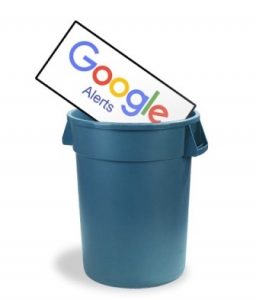— March 7, 2019
(March 08, 2019) morning, Google Ads announced that it will sunset average position—one of the original Search metrics—in September of this year.
What is average position? When you’re competing in the Google Ads auction, you’re assigned an Ad Rank based on your bid and your Quality Score. Ad Rank, in turn, determines where your ad lands in the paid search results—it determines your ad’s position.
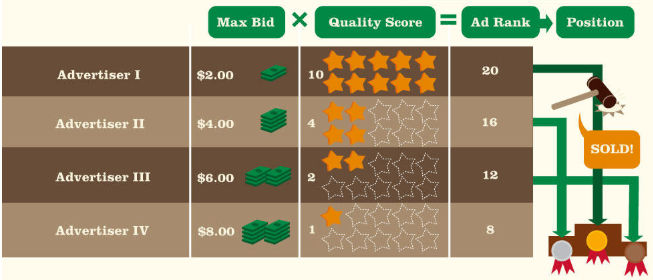
Ad position refers to the ordering of the paid search results, but not the location of the paid search results. In other words, if you achieve the top ad position (1) in a given auction, that doesn’t necessarily mean that your ad is showing at the top of the SERP. It could very well be showing under the organic search results.
As such, your average position doesn’t tell you the whole story in terms of where your Search ads are showing. Certainly, this caveat has caused business owners and account managers alike some confusion.
First, let’s talk about why Google Ads is doing this. Then, we’ll dive into some of the reactions from WordStream employees and other PPC experts. We’ll wrap up with some perspective and a couple action items.
Why is average position going away?
In short: because Google doesn’t think it’s a terribly useful metric anymore.
Accordingly, last November, Google Ads rolled out a suite of new metrics pertaining to auction performance and SERP visibility:
- Top impression rate tells you the percentage of your total impressions that are coming from the top of the SERP (above the organic results).
Top impression rate = Top impressions / Total impressions
- Absolute top impression rate tells you the percentage of your total impressions that are coming from the very top of the SERP.
Absolute top impression rate = Absolute top impressions / Total impressions
- Top impression share tells you the rate at which you’re turning opportunities to appear at the top of the SERP into actual impressions at the top of the SERP.
Top impression share = Top impressions / Eligible top impressions
- Absolute top impression share tells you the rate at which you’re turning opportunities to appear at the very top of the SERP into actual impressions at the very top of the SERP.
Absolute top impression share = Absolute top impressions / Eligible absolute top impressions
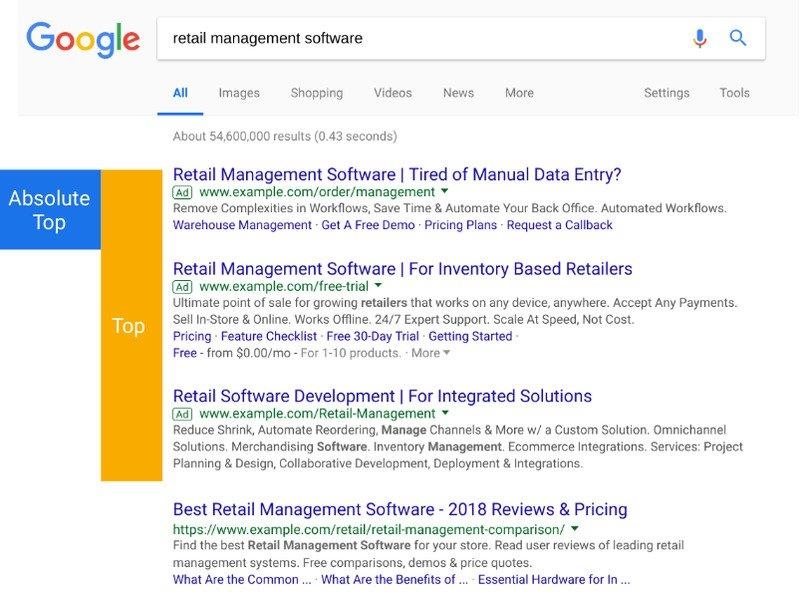
Via Google.
In the announcement post, Google Ads product manager Pallavi Naresh gave the following rationale for the decision: “These new metrics give you a much clearer view of your prominence on the page than average position does.”
Having a clear idea of your prominence on the SERP is essential to making informed bidding decisions. Evidently, Naresh and the rest of the team at Google think the four new metrics are more insightful as far as bidding strategy is concerned.
What do PPC experts think?
Google is certain that these four new metrics are more insightful than average position, and the PPC community doesn’t seem all that sad to see the metric go—for the most part. I spoke to some folks around the office to get their takes.
“This is another step in Google Ads’ shift to focusing on automated bidding strategies,” said Holly Niemiec, a member of our Managed Services team. “Because the goal of automated strategies is to get your ad wherever it has the best chance to convert—versus owning the top of the SERP—I think this decision reiterates the shift to automation and away from AdWords.”
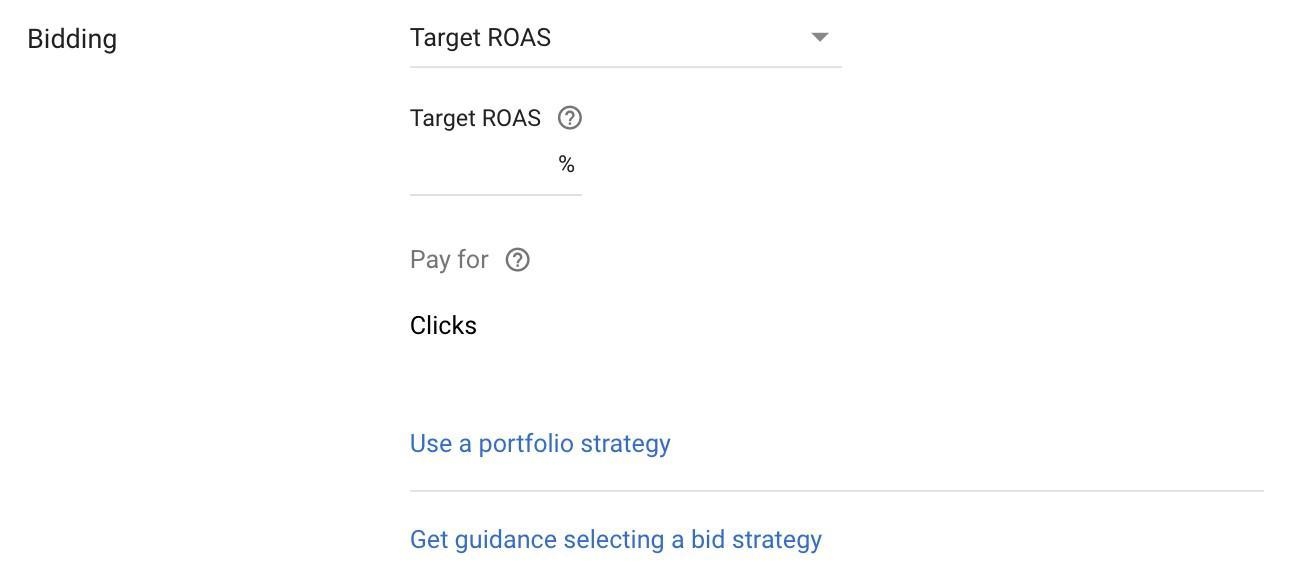
One of Google Ads’ automated bidding strategies lets you target ROAS.
Holly’s perspective falls somewhat in line with that of Frederick Vallaeys, who said the following in a Search Engine Land article: “Nowadays, automated bidding is so ubiquitous and cheap that [manual] bid-to-position strategies simply don’t make a lot of sense for the majority of advertisers.”
Courtney Charroux, a member of our Customer Success team, was slightly critical: “I’m an avid user of average position. I have a client in a very popular industry, and I like having those hard averages to identify my success with the account and to know where I should adjust.”
Note that Courtney shared this opinion in the context of a particular client. She told me, broadly speaking, that she thinks Google Ads’ impression-based metrics are, in fact, useful.
Dave Thorsen, also from our Managed Services team, finds average position useful—as long as it’s understood in conjunction with top impression share. “Otherwise, average position is a relative metric, and you don’t really know what it’s relative to.”
“I couldn’t believe Google Ads would get rid of such an important metric,” said Kristina Simonson, who runs paid search and social campaigns on our own marketing team, “until I realized I hadn’t used it to assess performance in months.”
“I couldn’t believe Google Ads would get rid of such an important metric—until I realized I hadn’t used it to assess performance in months.”
Although, like Courtney and Dave, Kristina still finds value in average position, she knows she’ll be able to rely on impression metrics when assessing performance.
In addition to WordStream HQ, the PPC world has been buzzing since the announcement. Here’s what Kirk Williams of ZATO Marketing had to say, in line with Holly and Kristina:

Aaron Levy of Elite SEM seems similarly unconcerned. (DSP stands for demand-side platform, which refers to a software that enables advertisers to automate their purchases.)
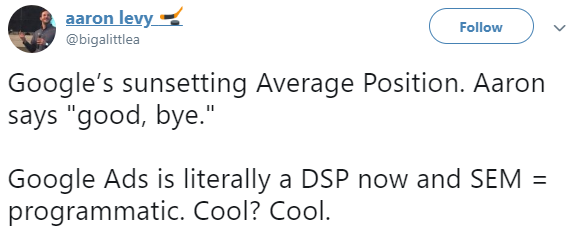
Finally, in her blog post, Kamlyn Spivey of PPCHero encourages advertisers to remain calm. With six months to prepare and the ability to influence page placement with the Target Impression Share bidding strategy, Kamlyn is certain you’ll emerge (relatively) unscathed.
What comes next?
The consensus seems pretty clear. Although average position has provided valuable insights to advertisers over the years, its impending removal from your Google Ads account is far from the end of the world.
You hear this all the time—and you’re probably tired of hearing it—but it’s true: PPC is a constantly evolving method of advertising. And as plenty of people at WordStream and beyond have pointed out in the wake of this announcement, automation is becoming increasingly commonplace. The sunsetting of average position—long leveraged for the sake of manual bidding strategy—reflects that.
Does that mean the days of account managers are numbered? Not at all. As useful as automation is, it’s not a replacement—it’s a supplement. You won’t be able to kick your feet up and let machines do all the heavy lifting any time soon.
Here are some action items you can walk away with:
- If you find average position useful, continue to take advantage of it while you can. Every Google Ads account is different, and if you’ve used average position to optimize your bids in the past, there’s no reason that needs to change before September.
- Become more familiar with automated bidding strategies, particularly Target Impression Share. We have a complete guide to these strategies here. Your comfort with these will only become more important as time goes on.
Digital & Social Articles on Business 2 Community
(58)
